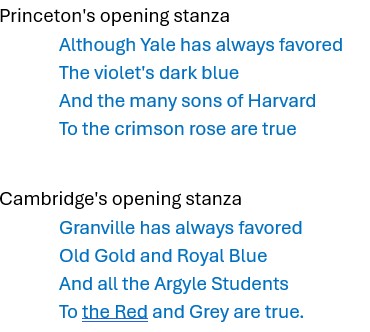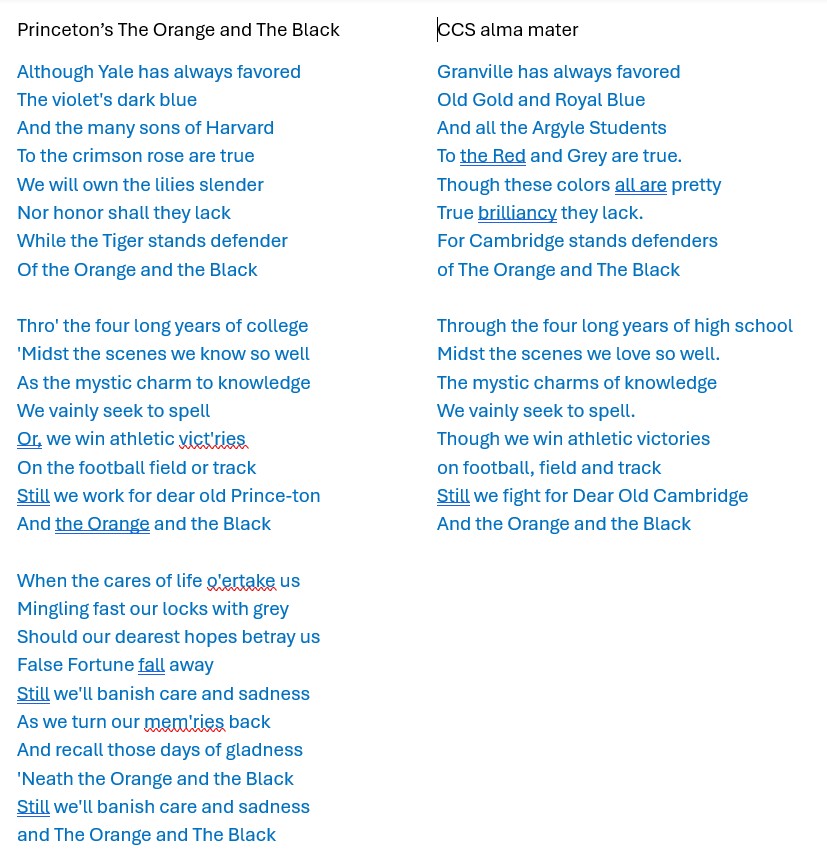The Elementary Chorus is learning about our alma mater. I was asked to talk to them about its history. As usual, I found lots of “facts”, but I also spun a few stories to stitch the facts together to explain what might have happened 125 years ago.
Why Granville? Why Argyle?
Why does the Cambridge alma mater start by singing about Granville and Argyle? I blame it on two students at Princeton University in 1888. Here’s my theory.
Princeton University adopted the colors orange and black for their athletic teams in 1874.
Originally, Princeton competed against Harvard, Yale, and Dartmouth. In 1888 when Princeton student Clarence Mitchell wrote the song “The Orange and the Black” he started by referring to the blue favored by Yale and the crimson worn by Harvard.
The Cambridge athletic teams also wore orange and black. When Cambridge adopted the Princeton song, we kept the format of the lyrics. Princeton’s references to Yale and Harvard in its opening lines were changed to Granville and Argyle in our alma mater. It looks like we found local schools whose colors were like Yale (blue) and Harvard (red).

I wonder, if Mitchell’s song had referenced Yale and Dartmouth instead of Yale and Harvard, would our song have started singing about Granville and Greenwich since Dartmouth’s school color is Forest Green.
East End? West End?
In the late 1800s, colleges created school songs to foster school spirit, honor tradition, and build a sense of identity and loyalty among students and alumni. That’s exactly what Cambridge needed to unite the East End and the West End.
In 1891, the Washington Academy on the West End and the Putnam Institute on the East End closed and all students moved into the Cambridge Union School located just west of the Rice Seed campus. But people needed to be convinced this was a good decision. I think maybe we decided a school song was the unifying factor that was needed.
Football? Track?
For a song, we had a choice. We could write our own or we could copy someone else’s. We copied Princeton’s, changing the first verse to refer to Granville and Argyle. But what about the second verse “… though we win athletic victories on the football field or track”.
When Cambridge High School opened, they played two sports: baseball and girl’s lawn tennis. Football was not yet a popular high school sport, it was primarily a college sport. As for track, it wasn’t until a few years later that we used the horse track at the fairgrounds for that sport.
So, I wonder, when they first sang the second verse did people asked “Football? What’s that? And what’s a Track?”.
How many verses?
In 1938 the high school classes had a competition to see who could sing the song the best. The song they sung had two verses.
Pauline’s website lists three verses to the alma mater. But the third verse is the same as Princeton’s, with no changes. Was that verse ever adopted by Cambridge or did someone doing history research simply copy it from Princeton and we all just assumed it was our third verse? I don’t know, but I’ve never heard the third verse sung at Cambridge.
Who did it?
I’ve heard that Harriet King Perry converted the lyrics of the first two verses of Princeton’s 3-verse song to be Cambridge-specific. Harriet was 62 years old when the Cambridge Union School opened in 1891 so why would she be chosen to convert the words? Did she have a connection to Princeton? How did she know Princeton used orange and black as their school color?
Harriet was from White Creek so likely didn’t have that much interest in East End vs West End within the Cambridge Village. However, Harriet’s daughter, Sarah, was a long-time teacher in many one-room schoolhouses in our community and for a few years in the Union School. So maybe Harriet created the song as a memory to Sarah who died at age 50.
I’ve also heard that Elizebeth Perry converted the lyrics. I can’t find any notes so I can’t cite the source for either Harriet or Elizabeth. A ton of school history was destroyed in Aug-1947 when the Old School burned. Perhaps that’s where the true story of our song vanished.
